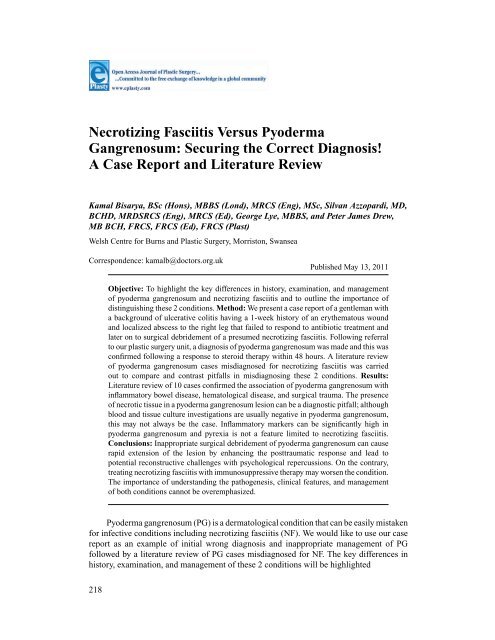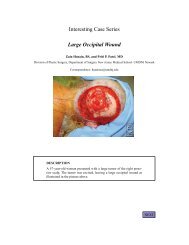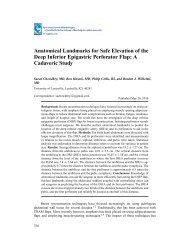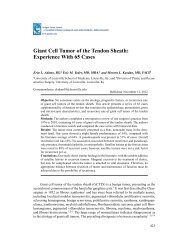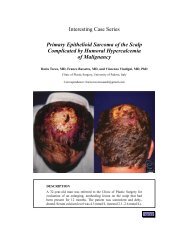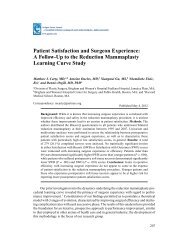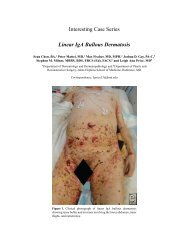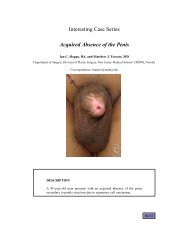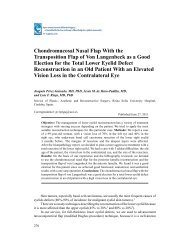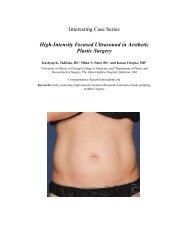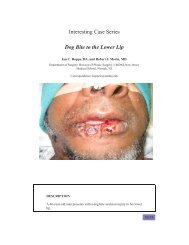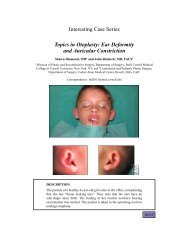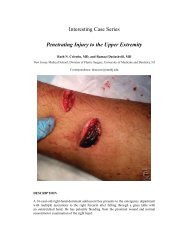A Case Report and Literature Review - ePlasty
A Case Report and Literature Review - ePlasty
A Case Report and Literature Review - ePlasty
You also want an ePaper? Increase the reach of your titles
YUMPU automatically turns print PDFs into web optimized ePapers that Google loves.
Necrotizing Fasciitis Versus PyodermaGangrenosum: Securing the Correct Diagnosis!A <strong>Case</strong> <strong>Report</strong> <strong>and</strong> <strong>Literature</strong> <strong>Review</strong>Kamal Bisarya, BSc (Hons), MBBS (Lond), MRCS (Eng), MSc, Silvan Azzopardi, MD,BCHD, MRDSRCS (Eng), MRCS (Ed), George Lye, MBBS, <strong>and</strong> Peter James Drew,MB BCH, FRCS, FRCS (Ed), FRCS (Plast)Welsh Centre for Burns <strong>and</strong> Plastic Surgery, Morriston, SwanseaCorrespondence: kamalb@doctors.org.ukPublished May 13, 2011Objective: To highlight the key differences in history, examination, <strong>and</strong> managementof pyoderma gangrenosum <strong>and</strong> necrotizing fasciitis <strong>and</strong> to outline the importance ofdistinguishing these 2 conditions. Method: We present a case report of a gentleman witha background of ulcerative colitis having a 1-week history of an erythematous wound<strong>and</strong> localized abscess to the right leg that failed to respond to antibiotic treatment <strong>and</strong>later on to surgical debridement of a presumed necrotizing fasciitis. Following referralto our plastic surgery unit, a diagnosis of pyoderma gangrenosum was made <strong>and</strong> this wasconfirmed following a response to steroid therapy within 48 hours. A literature reviewof pyoderma gangrenosum cases misdiagnosed for necrotizing fasciitis was carriedout to compare <strong>and</strong> contrast pitfalls in misdiagnosing these 2 conditions. Results:<strong>Literature</strong> review of 10 cases confirmed the association of pyoderma gangrenosum withinflammatory bowel disease, hematological disease, <strong>and</strong> surgical trauma. The presenceof necrotic tissue in a pyoderma gangrenosum lesion can be a diagnostic pitfall; althoughblood <strong>and</strong> tissue culture investigations are usually negative in pyoderma gangrenosum,this may not always be the case. Inflammatory markers can be significantly high inpyoderma gangrenosum <strong>and</strong> pyrexia is not a feature limited to necrotizing fasciitis.Conclusions: Inappropriate surgical debridement of pyoderma gangrenosum can causerapid extension of the lesion by enhancing the posttraumatic response <strong>and</strong> lead topotential reconstructive challenges with psychological repercussions. On the contrary,treating necrotizing fasciitis with immunosuppressive therapy may worsen the condition.The importance of underst<strong>and</strong>ing the pathogenesis, clinical features, <strong>and</strong> managementof both conditions cannot be overemphasized.Pyoderma gangrenosum (PG) is a dermatological condition that can be easily mistakenfor infective conditions including necrotizing fasciitis (NF). We would like to use our casereport as an example of initial wrong diagnosis <strong>and</strong> inappropriate management of PGfollowed by a literature review of PG cases misdiagnosed for NF. The key differences inhistory, examination, <strong>and</strong> management of these 2 conditions will be highlighted218
BISARYA ET ALMETHODSWe located all articles reported in the English language where PG was mistaken for NFby conducting a literature search on PubMed using the following key words: necrotizingfasciitis, pyoderma gangrenosum, misdiagnosis, <strong>and</strong> case reports. Nine cases were identified<strong>and</strong> analyzed to synthesize our data, which were summarized in table format to highlightthe chronology of clinical progression in each case.CASE REPORTJ.W. was a 33-year-old male IT analyst whose medical background included ulcerativecolitis for which he was on pentase <strong>and</strong> predfoam enema. He was referred by the generalpractitioner (family physician to the emergency department with a 1-week history of anerythematous wound to his right lateral leg with no improvement on oral flucloxacillin.Hospital review revealed development of a “localized abscess,” <strong>and</strong> associated inflammatorymarkers included a White cell count (WCC) 13.4 <strong>and</strong> Creactive protein (CRP)179. Subsequently the patient was admitted by the orthopedic team <strong>and</strong> treated withintravenous antibiotics (benzylpenicillin, flucloxacillin, <strong>and</strong> metronidazole). Four days laterhe underwent incision <strong>and</strong> drainage where the operative findings confirmed “blood stainedpus.” Two days later, an increase in the WCC to 20.3 <strong>and</strong> CRP to 283 was observed <strong>and</strong> afurther debridement of a 25×15-cm area was undertaken where “a bubbly appearance of themargins, extensive erythema <strong>and</strong> necrosis of the skin distal to the wound, discharge <strong>and</strong> fatnecrosis” were noted. Histology confirmed inflammation with necrosis of the tissues, butGram stain showed no specific organism <strong>and</strong> wound swabs only grew coagulative negativeStaphylococcus. The case was discussed with the microbiologists who recommendedtreating the patient with a provisional diagnosis of NF. However, as there was no clinicalimprovement at this stage, he was referred to our burns <strong>and</strong> plastic surgery department.An assessment in theatre found “purple borders around the wound, <strong>and</strong> subcutaneouspockets of pus which discharged on palpation.” Histology confirmed “an ulcer <strong>and</strong> abscesswith acute inflammation <strong>and</strong> fibrosis <strong>and</strong> granulation tissue which extends to the marginswith no vasculitis or neoplasia.” Microbiology failed to show any growth. Based on theseclinical findings, histology, <strong>and</strong> microbiology, a diagnosis of PG was made <strong>and</strong> the patientwas commenced on prednislone 40 mg. Subsequent review revealed improvement within48 hours with no extension of the wound, <strong>and</strong> the patient went on to have a split-skin graftto cover the previous defect with subsequent full recovery (Fig 1).RESULTS/ANALYSIS OF THE LITERATURETable 1 summarizes the English literature review of cases where PG has been misdiagnosedfor NF. The association of PG with a medical or family history of inflammatory boweldisease (case Nos. 1, 2, 3, 6, 7, 10), surgical trauma <strong>and</strong>/or worsening after surgery or evenintravenous cannulation (case Nos. 1 2, 3, 5, 6, 7, 8), <strong>and</strong> an association with hematologicaldisease (case No. 9) can all be demonstrated. All cases of PG were initially misdiagnosedas being infective conditions ranging from abscess to cellulitis or NF <strong>and</strong> were accordinglytreated with antibiotics, surgical debridement including multiple debridements (case Nos.6,7), repeated excision for histology sampling (case Nos. 9), <strong>and</strong> even digit or partial toeamputations (case Nos. 1, 3).219
<strong>ePlasty</strong> VOLUME 11Table 1. <strong>Literature</strong> review of cases of pyoderma gangrenosum misdiagnosed for necrotizing fasciitisAge, Initial 2 ◦ Diagnosis /2 ◦ ResponseN 0 Author y; sex Affected area PMH diagnosis BC TC Histology 1 ◦ Mx Mx of PG time to Rx1 TayYK 719982 Bennett 2119993 Bennett 21199938; F Erythematous painfulplaques leftpalm/middle finger.(similar history 2 ybefore 2 ◦ to blunttrauma) Sites ofintravenous (IV)cannula (later)25; F Febrile with cellulitis toskin of MCP jointspostrevisionarthroplasty <strong>and</strong>removal of siliconeimplants bullae;ulcers with purplehue 2/52 later32; F Infected tarsal tunnelrelease wound rightfoot CellulitisPustules/necrotictissue (later) SSGdonor site – pustularlesions (14/52 later)Crohn diseasediagnosis of3yprednislonediscontinuedJuvenile RACrohndisease1. Cellulitis2. Necrotizingfasciitis1. Cellulitis2. AbscessNil 1. Abscess2. Cellulitis-ve Left-finger ulcerNonspecificneutrophilicdermalinfiltrate1. Anitbiotics2. Debridement3. Amputation of digits-ve Not reported 1. IV antibiotics2. Drainage3. Debridement+ve −ve* Not reported 1. Antibiotics2. Debridement x83. BKA proposed4. HB oxygen5. SSG with 90% take6. Partial toeamputation≥ 1wk after day 1MPSS for 3/7prednislonesulfasalazine2/52 after day 1 MPSSfor 3/7 PrednislonePo14/52 later PrednislonePO12 h24 hGradual over 3/12220
BISARYA ET ALTable 1. ContinuedAge, Initial 2 ◦ Diagnosis /2 ◦ ResponseN 0 Author y; sex Affected area PMH diagnosis BC TC Histology 1 ◦ Mx Mx of PG time to Rx4 Waterworth 2220045 Mahajan 2320056 Chia 9200858; F RT breast, extremepain, swollen, redskin that discoloredblack in a few hours.Rapid progressNo history of trauma orsurgery42; F Inflammation skinnecrosis post lapchole.IV cannula sitesblistered withabscessSkin graft edgenecrosis/ulceration(4/52 from day 1)44; M Ankle ulcers, erythema/abscess that healReadmission withnecrotizing fasciitis/pyrexia/unwellCrusting, pustules,violet erythemadonor site of SSGarea; left thigh3-4/52 post-SSGUlcerativecolitis(years) OnPrednisloneDVT (1/52ago)Varicose VOn warfarinNil No diseaseassociatedwith PGUlcerativecolitisdiagnosis8yNotonRx inremissionAbscesshematoma2 ◦ towarfarinNec Fasciitis-ve Carried out butnot reportedNec Fasciitis -ve NeutrophilicdermatitisNo fascialnecrosis1. AbscessAnkle2. Graft failure<strong>and</strong> promptdermatologyreview† +ve From SSG donorsiteNeutrophilicdermatitisPerivascularplasma whiteblood cellinfiltrateSurgical explorationLater excision ofnecrotic skin <strong>and</strong>healing by 2 ◦intention1. Anitbiotics2. Debridement3. Vac dressing4. Skin Grafting1. Abscess excisedResponse toantibiotics2. Necrotizing fasciitisankle <strong>and</strong> moreantibiotic/debridement3. SS G to ankle2/7 after day 1Cyclosporin A↑Prednislone dose4/52 later MPSS for 3/7Oral SteroidsMycophenolatePrednislone 72 hTime scale notSpecifiedFew hours221
<strong>ePlasty</strong> VOLUME 117 Barr 2420088 Jaivsminsayna 2520099 Ayestaray 19201010 Our case201070; F Erythema pus neck2/52 after BCCexcisionDusky necrosis at CVPline/chest drain site56; M Postoperativeappendicectomywound with pain,discharge, <strong>and</strong>ulcerationLater—nodules/ulceration at cannulasite64; M Cellulitis right arminitially butdeveloping centralnecrosis within firstweek suggestingnecrotizing fasciitis33; M 1-wk history oferythematous wound<strong>and</strong> localized abscessto right lateral aspectlegHistory of GISx NieceCrohndisease-ve Autoimmunemarkers1. Cellulitis2. Necrotizingfasciitis3. Septic ShockNecrotizingfasciitis with2 ◦ sepsisVaquez disease CellulitisnecrotizingfasciitisUlcerativecolitis1. Abscess2. Necrotizingfasciitis-ve +ve Ulcers necrosis‡inflammationconsistent withnecrotizing fasciitis-ve Histology consistentwith necrotizingfasciitis1. Antibiotics2. Debridementmultiple3. ITU administrationwith shock1. Anitbiotics2. debridement3. ITU care-ve <strong>Report</strong>ed to favor PG 1. IV antibiotics2. Repeat Excision(Inflammation worsepost surgery)3. Thin SSG with mesh-ve Ulcer, abscess, <strong>and</strong>inflammation withno vasculitis norneoplasia1. Antibiotics PO/IV2. Debridement≤ 1wk after day 1 IVsteroids7dIV steroids InstantTime scale notspecified IV steroids∼ 2/52 after day 1Prednislone PO48 h48 hMx indicates managment; PMH, past madical history; MPSS, methylprednisilone (sodium succinate); BKA, below knee amputation; BC, blood culture; TC tissue culture; ITU, intensivetherapy unit; RT, right; CVP, central venous pressure.* Positive from wound 9 days postoperatively: Staphylococcus aureus <strong>and</strong> Enterobacter cloacae. Diagnosis of infection but pustules <strong>and</strong> areas of necrotic tissue noted. Subsequently allcultures were negative; pustular <strong>and</strong> vesicular lesion present.†Wound culture from ankle the initially effected site isolated Staphylococcus aureus with mixed growth but more likely to be colonizers. Inflammatory pustules in SSG donor site confirmneutrophilic pus; mixed growth of skin commensals in wound culture but no evidence of bacterial infection—diagnosis of pustular PG.‡ Although first histology report confirmed ulcers, inflammation, <strong>and</strong> necrosis consistent with necrotizing fasciitis, the second histology sample taken after neck debridement was reportedas ulcerated skin with exuberant dermal <strong>and</strong> subcutaneous inflammation <strong>and</strong> necrosis with bacteria in necrotic areas. This could still be necrotizing fasciitis but could also be colonized orinfected PG222
BISARYA ET ALFigure 1. Lower limb highlighting worsening of Pyoderma gangrenosum postdebridement.The presence of necrotic tissue can be a diagnostic pitfall, this is seen, for example, incase No. 9, where the patient at one point in his clinical course had intense pain, pyrexia,inflamed skin, <strong>and</strong> necrotic tissue favoring NF as a diagnosis but preoperatively superficial<strong>and</strong> muscular fascia appeared healthy. Necrotic tissue was also seen in case Nos. 3, 5, <strong>and</strong> 7.The presentation of case No. 4 also is misleading, where a 58-year-old woman presents withextreme right breast pain, swollen red skin that rapidly progresses to a black discolorationwithin a few hours <strong>and</strong> eventually does require excision of necrotic areas <strong>and</strong> healing bysecondary intention. In any case the presence of necrotic tissue makes the diagnosis of PGmore obscure.In the cases listed in Table 1, while blood culture <strong>and</strong>/or tissue culture investigationsincluding wound swabs yielded no positive microbiology in several instances—thus excludingan infective etiology—this was not always the case. <strong>Case</strong> No. 6 grew culturesthat isolated Staphylococcus aureus with mixed growth from an ankle wound that initiallypresented with ulcers, erythema, <strong>and</strong> abscesses but subsequently responded to surgicaldebridement only to recur again <strong>and</strong> be misdiagnosed as NF. This same patient developedviolaceous ulcers in an SSG donor site that grew mixed growth of skin commensals; in bothinstances the positive cultures were more likely to be colonizers as this was a case of PGnot NF. In case No. 3, Staphylococcus aureus <strong>and</strong> Enterobacter cloacae were grown froma postoperative wound, which had pustules <strong>and</strong> areas of necrotic tissue but subsequentlyall cultures were negative while pustular <strong>and</strong> vesicular lesions were noted. <strong>Case</strong> No. 7also presents a similar diagnostic dilemma between NF or colonized or infected PG withnecrotic tissue.223
<strong>ePlasty</strong> VOLUME 11Table 2. Comparison of pathology <strong>and</strong> clinical features of pyoderma gangrenosum <strong>and</strong> necrotizingfasciitis.Pyoderma gangrenosumNecrotizing fasciitisPathologyNoninfectious neutrophilic dermatosisDermis involvedMay have necrotic areasClinicalStrong link with inflammatory bowel diseaseSlower progression within daysDoes not resemble cellulitisViolaceous ulcer edge is typicalUnlikely to develop sepsisUnlikely to require ITU careWorsens with surgeryFascial planes have normal resistance to dissectionResponds to immunosuppressive therapyNo response to antibiotics <strong>and</strong> worsens with surgeryUsually negative blood <strong>and</strong> tissue culturesITU indicates, Intensive Therapy Unit.Necrotic soft tissue infectionFascia <strong>and</strong> subcutaneous fat involvedWill have necrosisNo association with inflammatory bowel diseaseRapid progressionCan resemble cellulitis in early stageViolaceous ulcer edge not a typical featureSeptic picture can developLikely to require ITU careResponds to surgeryLack of resistance to blunt dissection of fascial planesWorsens with immunosuppressive therapyShould respond to antibiotics <strong>and</strong> surgeryUsually positive blood <strong>and</strong> tissue culturesThe biochemical markers in the PG cases reported earlier do not always follow aconsistent pattern, CRP ranges from 14.5 (case No. 6) to 269 (case No. 9) were noted inactive stages of the disease <strong>and</strong> similarly white blood cell count has been reported as normal(case No. 6) or raised (case No. 9). Pyrexia is not a sign restricted to NF <strong>and</strong> this has beennoted in case Nos. 5, 8, 9, <strong>and</strong> 3 the latter as high as 39.8 ◦ C.The time scale between initial presentation to making a definite diagnosis of PG <strong>and</strong>initiating appropriate treatment ranged from 2 days to 4 weeks, although case No. 3 had anapproximate 14-week delay in having a correct diagnosis, this was established on a graftdonor site that developed pustular lesions <strong>and</strong> not on the initial operative site, which bythen had healed. In these cases, the initial response to treatment of PG was noted as earlyas a few hours up to within 3 days of treatment. The delay in clinching a proper diagnosisshows the extent of the diagnostic dilemma at times.DISCUSSIONPyoderma gangrenosum versus necrotizing fasciitisIn 1930, Brunsting et al 1 reported clinical <strong>and</strong> experimental observations in 5 cases ofpyoderma (ecthyma) gangrenosum in adults, the condition erroneously being thought to bea streptococcal or staphylococcal infection. 1 A number of cases of PG have been reported inthe literature (Table 2) to be misdiagnosed for NF, despite the fact that the pathophysiology<strong>and</strong> management of both conditions are totally different.Pyoderma gangrenosum is a rare, primarily sterile inflammatory neutrophilicdermatosis 2 that may present in ulcerative, pustular, bullous, <strong>and</strong> vegetative forms. 3 Thiscondition has an incidence of 3 to 10 per million per year 4 <strong>and</strong> it can affect all age groupswith the youngest documented patient being a 3-week-old newborn. 5 Women are more224
BISARYA ET ALoften affected than men <strong>and</strong> the peak incidence for adult females is in the third <strong>and</strong> fourthdecades <strong>and</strong> for males it is in the fifth decade. 6 It is found in up to 5% of patients withulcerative colitis <strong>and</strong> in up to 1.5% of patients with Crohn disease. 7,8 It is known to be associatedwith systemic disease such as rheumatoid arthritis, ankylosing spondylitis, leukemia,myelodysplasia, lymphoma, <strong>and</strong> other miscellaneous disorders such as sarcoidosis, humanimmunodeficiency virus infection, <strong>and</strong> systemic lupus erythematosus. 7,9 Up to 40% ofpatients may have PG lesions in the absence of associated disease 4 <strong>and</strong> history of pathergywhereby lesions are precipitated by trauma is reported in 25% of patients. 4One of the challenges in making a correct diagnosis of PG lies in the fact that itrelies heavily on clinical signs as there are no immunofluorescent markers, <strong>and</strong> in addition,histopathology is nonspecific <strong>and</strong> changes with progression of the lesion. 2,7 Themorphological evolution of PG lesions encompasses perivascular lymphocytic infiltrationassociated with endothelial swelling, while ulceration, areas of necrosis, infarction, <strong>and</strong>abscess formation may be found in the later stages. 10 Pyoderma gangrenosum lesions havea predilection for the pretibial areas, although they can affect any other body site includingoral, genital mucosa, <strong>and</strong> viscera such as lung or spleen. 2 A typical lesion would be afollicular pustule that ulcerates <strong>and</strong> is surrounded by erythematous, edematous skin. Theragged, undermined, <strong>and</strong> violaceous or bluish ulcer border are distinctive of this condition<strong>and</strong> key in making the diagnosis. 2,6 The 6 disease categories that are included in differentialdiagnosis of PG are infective such as NF, vascular occlusive or venous disease, vasculiticprocesses such as Wegener’s, malignancy such as lymphoma or leukemia, pustular drugreactions, <strong>and</strong> exogenous tissue injury such as insect bites. 2,11Necrotizing fasciitis is a relatively uncommon, potentially fatal, poly- or monomicrobialinfection predominately involving subcutaneous fat, superficial fascia, <strong>and</strong> deep fascia.This condition not only is limited to susceptible patients such as the malnourished, obese,immunocompromised, diabetic patients or those with malignant disease (type1 NF) but mayaffect previously healthy individuals who report a history of only minor trauma, such as afterpenetrating insect bites (type 2 NF). 12,13 Necrotizing fasciitis has been documented to occurin virtually all anatomical regions of the body but has a predilection for the extremities, theperineum following an ischiorectal or pilonidal abscess <strong>and</strong> the abdominal wall such as afterabdominal surgery. 12 In a study of 83 patients with NF treated over a 17-year period, 14 thecommonest pathogenic aerobes were Staphylococcus aureus followed by Escherichia coli<strong>and</strong> then group A streptococci. The predominant anaerobes were Peptostreptococcus spp,Prevotella, Porphyromonas, Bacteroides fragilis group, <strong>and</strong> Clostridium spp. Anaerobesoutnumbered aerobes <strong>and</strong> certain microorganisms were associated with specific conditionssuch as Pseudomonas with immunosuppression <strong>and</strong> malignancy, Bacteroides spp withdiabetes, <strong>and</strong> clostridium with trauma. 14 Necrotizing fasciitis may present with a patchydiscoloration of the skin <strong>and</strong> ill-defined erythema that can rapidly be followed by a tenseoedema while vesicles <strong>and</strong> bullae may appear together with necrosis. Pain is generallyout of proportion to the physical findings while the patient can rapidly become septic <strong>and</strong>systemically unwell. 12,15Diagnosis of NF is guided by clinical features, blood cultures, <strong>and</strong> Gram stain toidentify causative organisms, 16 together with scoring tools such as the Laboratory RiskIndicator for Necrotizing fasciitis, which takes into account CRP, serum Na + , Cr, glucose,WCC, <strong>and</strong> hemoglobin to calculate a low, intermediate, or high risk of NF. 17 Magneticresonance imaging excludes NF if deep fascial involvement is not demonstrated; however,225
<strong>ePlasty</strong> VOLUME 11this modality of investigation has its limitations as primarily sensitivity is greater thanspecificity <strong>and</strong> there are time constraints within which to secure the diagnosis. 18 The goldst<strong>and</strong>ard for diagnosis of NF is direct inspection of fascia at surgery 16 <strong>and</strong> histology that willreveal minimal change in epidermis, a lymphohistiocytic infiltrate in dermis, suppuration,with necrosis of superficial fascia <strong>and</strong> blood vessel thrombosis <strong>and</strong> oedema in the fascialplanes. 12Clearly these 2 conditions have different pathophysiology <strong>and</strong> clinical features; Table 1compares <strong>and</strong> contrasts PG with NF to highlight salient points that may prevent misdiagnosisof either condition.CONCLUSIONAlthough several of the clinical features outlined earlier can be identified in the literaturereview cases, the clinical presentation of either condition may be atypical <strong>and</strong> this, coupledwith confounding laboratory or histological results, creates diagnostic pitfalls.The importance of underst<strong>and</strong>ing the pathogenesis, clinical features, <strong>and</strong> managementof both conditions cannot be overemphasized. Aggressive management of PG withantibiotics <strong>and</strong> extensive surgical debridement not only will lead to large tissue defectswith potential reconstructive challenges 7 but can cause rapid extension of the lesion byenhancing the posttraumatic response. 19 On the contrary, treating NF with immunosuppressivetherapy may worsen the condition <strong>and</strong> some authors recommend corticosteroidtherapy in association with antibiotics in dubious cases. 19 The psychological repercussionsof misdiagnosis <strong>and</strong> incorrect management especially that leading to tissue loss are not tobe underestimated. 20 This article highlights how important it is to apply the basic principlesof surgery into clinical practice <strong>and</strong> formulate a diagnosis on the basis of proper history,clinical examination, <strong>and</strong> investigations; it is crucial to reconsider the preliminary workingdiagnosis if an expected clinical response is not observed.REFERENCES1. Brunsting LA, Goerckerman WH, O’Leary PA. Pyoderma (ecthyema) gangrenosum: clinical <strong>and</strong> experimentalobservations in five cases occurring in adults. Arch Dermatol Syph. 1930;22:655-68.2. Uwe W. Pyoderma Gangrenosum—a review [published online ahead of print April 15, 2007]. Orphanet JRare Dis. 2007;2:19. doi: 10.1186/1750-1172-2-19.3. Powell FC, Su WPD. Pyoderma gangrenosum: classification <strong>and</strong> management. J Am Acad Dermatol.1996;34:395-409.4. Powell FC, Schroeter AL, Su WP, et al. Pyoderma gangrenosum: a review of 86 patients. QJMed.1985;55:173-86.5. Graham JA, Hansen KK, Rabinowitz LG, Esterly NB. Pyoderma gangrenosum in infants <strong>and</strong> children.Pediatr Dermatol. 1994;11(1):10-7.6. Perry HO. Pyoderma gangrenosum. South Med J. 1969;62:899-908.7. Tay YK, Friednash M, Aeling JL. Acute pyoderma gangrenosum does not require surgical therapy. ArchFam Med. 1998;7(4):377-80.8. Keltz M, Lebwohl M, Bishop S. Peristomal pyoderma gangrenosum. J Am Acad Dermatol. 1992;27:360-64.9. Chia MW, Teo L, Tay YK, Poh WT. Pustular pyoderma gangrenosum: an uncommon variant which is easilymisdiagnosed. Dermatol Online J. 2008;14(2):2.226
BISARYA ET AL10. Su WP, Schroeter AL, Perry HO, Powell FC. Histopathologic <strong>and</strong> immunopathologic study of pyodermagangrenosum. J Cutan Pathol. 1986;13(5):323-30.11. Weenig RH, Davis MD, Dahl PR, et al. Skin ulcers misdiagnosed as pyoderma gangrenosum. N Engl JMed. 2002;347:1412-8. doi: 10.1056/NEJMoa013383.12. Green RJ, Dafoe DC, Raffin TA. Necrotizing fasciitis. Chest 1996;110:219-29. doi: 10.1378/chest.110.1.219.13. Puvanendran R, Chan Meng Huey J, Pasupathy S. Necrotizing fasciitis. Clin Rev. 2009;55(10):981-7.14. Brook I, Frazier EH. Clinical <strong>and</strong> microbiological features of necrotizing fasciitis. J Clin Microbiol.1995;33(9):2382-7.15. Wilkerson R, Paull W, Coville FV. Necrotizing fasciitis: review of the literature <strong>and</strong> case report. Chin OrthopRelated Res. 1987;216:187-92.16. Salcido R, Ahn C. Necrotizing fasciitis: reviewing the causes <strong>and</strong> treatment strategies. Adv Skin WoundCare J Prev Heal. 2007;20(5):288-93.17. Wong CH, Khin LW, Heng KS, Tan KC, Low CO. The LRINEC (laboratory risk indicator for necrotizingfasciitis) score: a tool for distinguishing necrotizing fasciitis from other soft tissue infections. Crit CareMed. 2004;32(7):1535-41.18. Schmid MR, Kossmann T, Duewell S. Differentiation of necrotizing fasciitis <strong>and</strong> cellulitis using MRimaging. Am J Roentgenol. 170:615-20.19. Ayestaray B, Dudrap E, Chartaux E, Verdier E, Joly P. Necrotizing pyoderma gangrenosum: an unusualdifferential diagnosis of necrotizing fasciitis. J Plast Reconstr Aesthet Surg. 2010;63(8):e655-8.20. L. Hemp, S. Hall. Pyoderma gangrenosum: from misdiagnosis to recognition, a personal perspective. JWound Care. 2009;18(12):521-6.21. Bennett CR, Brage ME, Mass DP. Pyoderma gangrenosum mimicking postoperative infection in the extremities.A report of two cases. J Bone Joint Surg. 1999;81:1013-8.22. Waterworth AS, Horgan K. Pyoderma gangrenosum—an unusual differential diagnosis for acute infection.Breast. 2004;13(3):250-3.23. Mahajan AL, Ajmal N, Barry J, Barnes L, Lawlor D. Could your case of necrotizing fasciitis be pyodermagangrenosum? Br J Plast Surg. 2005;58(3):409-12.24. Barr KL, Chhatwal HK, Wesson SK, Bhattacharyya I, Vincek V. Pyoderma gangrenosum masquerading asnecrotizing fasciitis [published online ahead of print October 2, 2008]. Am J Otolaryngol. 2009;30(4):273-6.25. Jasminsajna M, Chakravarty K. Post surgical wound inflammation—pyoderma gangrenosum or necrotizingfasciitis? A rheumatological solution. Paper presented at: British Society for Rheumatology <strong>and</strong> BritishHealth Professionals in Rheumatology Annual meetings; April 28 to May 1, 2009:48.227


